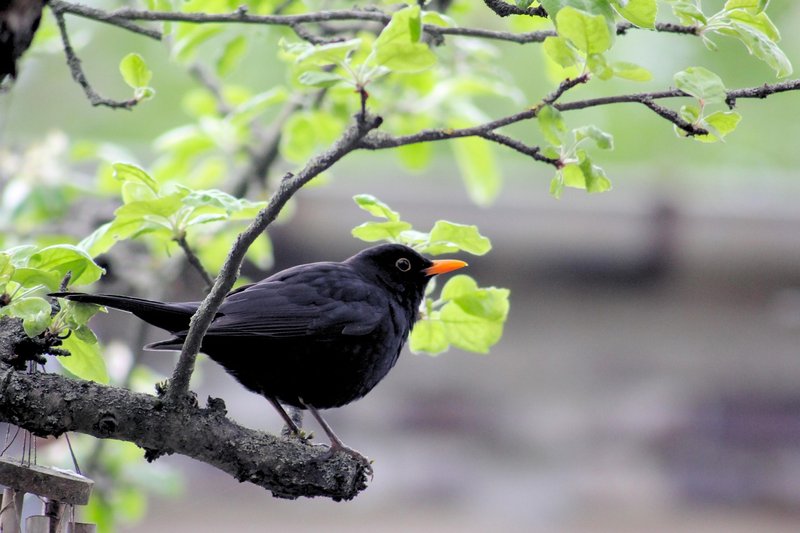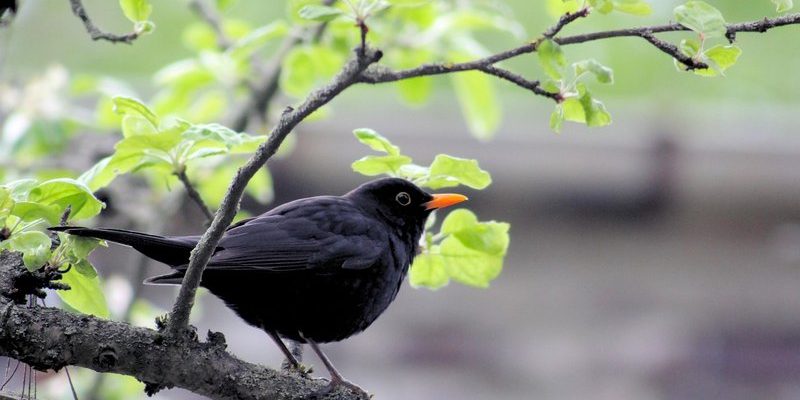
The Blackbird is a delightful songbird that captivates the hearts of many. With its striking dark feathers and captivating songs, this bird has a special place in various cultures and natural ecosystems. Imagine stepping into your backyard, coffee in hand, as the melodious tunes of a Blackbird fill the air. It’s like nature’s very own concert, performed just for you! This bird is not only known for its beautiful voice, but it also plays important roles in its habitat, influencing everything from pest control to seed dispersal.
You might be wondering why the Blackbird stands out among the numerous bird species. While many birds sport vibrant colors, the Blackbird’s charm lies in its smooth black plumage and the contrast of its bright yellow eye. These fascinating features make it easily recognizable, especially in Europe and North America, where it’s commonly found. But there’s so much more to these birds than meets the eye, and their behaviors, diets, and habitats contribute to their unique identity.
Physical Characteristics of the Blackbird
The Blackbird is a medium-sized bird with a generally robust body. Adults typically measure around 9 to 10 inches in length and weigh between 2.5 to 4 ounces. Males are easily distinguished by their all-black plumage and striking yellow eye-ring, while females are generally brown and mottled, providing excellent camouflage—especially when nesting. The contrasting colors of the males and females can be likened to a classic duet, each playing its part in the concert of life.
Another striking feature of the Blackbird is its long, slender tail, which it often spreads while singing. The tail acts like a visual aid during their performances, drawing attention not just to their beautiful songs but to their impressive aerial maneuvers as well. When you see a Blackbird perched on a tree branch, you’ll notice its bright orange-yellow beak, which is well-adapted for foraging. This beak is not just pretty, it’s a powerful tool that helps them dig up insects, fruits, and seeds.
Key Facts about the Blackbird
| Size: | 9-10 inches in length |
| Weight: | 2.5 – 4 ounces |
| Habitat: | Woodlands, gardens, and urban areas |
| Diet: | Fruits, insects, and seeds |
| Speed: | Up to 30 mph in short bursts |
| Lifespan: | 2-5 years in the wild |
Habitat and Distribution
The Blackbird is a versatile bird found in a variety of habitats. It thrives in woodlands, parks, and gardens, making it a familiar sight across Europe, Asia, and parts of North America. Think of the Blackbird as a traveler who effortlessly adapts to different environments while maintaining its own unique flair. Unlike many birds that prefer remote areas, Blackbirds are often spotted in urban settings, gracefully navigating through backyards and open fields.
While they flourish in gardens and parks, they also rely on dense vegetation for nesting. A typical Blackbird nest is built low to the ground in thick shrubs, giving their young a better chance of avoiding predators. You might find them in hedgerows or undergrowth where they feel safe. The adaptability of the Blackbird allows it not only to survive but to thrive in close proximity to humans. It’s a joy to witness their antics as they hop around, searching for food or chasing one another through the grass.
Behavior and Social Structure
Blackbirds are social creatures, often seen foraging in small groups. They communicate through a variety of sounds, from melodious whistles to harsh alarm calls. Their songs can be quite complex, often varying from individual to individual, much like different artists expressing themselves in unique styles. This vocalization is crucial, especially during the breeding season, when males use their songs to attract females and establish territory.
During migration, Blackbirds may travel in large flocks, forming impressive formations that dance through the sky. Watching these flocks is utterly mesmerizing, as they undulate and change direction in perfect harmony. When it comes to parenting, both the male and female Blackbird share the responsibility of raising their chicks. They work together to build the nest, incubate the eggs, and bring food to their hungry young. This teamwork is vital for the survival of their offspring, highlighting the strong family bonds within this species.
Diet and Feeding Habits
The diet of the Blackbird is quite diverse, consisting mainly of fruits, seeds, and insects. These birds are opportunistic feeders, meaning they take advantage of whatever food sources are available. In spring and summer, you might see them foraging for juicy berries, while in the colder months, they turn their attention to seeds and insects found under the snow. Their keen eyesight helps them spot food from a distance, making it easier to find meals even in challenging conditions.
Interestingly, the Blackbird has a knack for using its beak to dig into the ground, searching for worms and grubs. Have you ever seen them hopping around in the grass, pausing to poke their beaks into the soil? That’s their way of hunting for hidden treasures! This behavior not only provides them with nourishment but also helps control insect populations, making them valuable allies in your garden.
Blackbird Songs and Their Significance
The song of the Blackbird is often described as one of the most beautiful bird calls in the world. Males sing to attract mates and establish their territory, using a rich array of notes that can be enchanting to anyone who hears them. Picture a warm summer evening, the sun setting in the background, and the sweet sound of Blackbirds serenading each other. Their songs can evoke feelings of tranquility and connection to nature, reminding us of the simple pleasures in life.
This melodious performance not only serves a romantic purpose but also plays a vital role in communication. The variety of calls made by Blackbirds can convey different messages, from warnings of danger to signals of food sources. You might notice that when one Blackbird detects a predator, it quickly alerts the others, allowing them to take cover. This instinctive behavior showcases their intelligence and social dynamics, adding depth to their interactions.
Conservation Status
Currently, the Blackbird is categorized as a species of least concern, which means they have a stable population. However, like many birds, they face threats such as habitat loss, pollution, and climate change. Urban development can lead to the destruction of nesting sites and food sources, which can negatively impact their populations. This is why it’s important for us to create welcoming environments in our gardens and parks, allowing these beautiful creatures to thrive.
Many organizations work tirelessly to promote conservation efforts and educate the public about the importance of protecting the Blackbird’s habitat. Simple actions like planting native plants, providing water sources, and minimizing pesticide use can make a big difference. By being mindful of our surroundings, we can help ensure that future generations will also enjoy the sweet symphony of Blackbirds as they flit through our neighborhoods.
FAQ
What do Blackbirds use their nests for?
Blackbirds build their nests primarily for laying eggs and raising their young. The nests are usually made from twigs, grass, and mud, which provide a secure environment for the eggs. The female typically chooses the nesting site and ensures it’s hidden from predators, making it a safe haven for the hatchlings. After the chicks fledge, they often remain with their parents for a bit longer, learning how to forage and survive in the wild.
Are Blackbirds migratory birds?
Blackbirds are known for their migratory behavior in some regions, particularly in North America. They tend to migrate south during the colder months in search of more favorable conditions. This migration usually occurs in large flocks, making it a breathtaking sight to see them soar through the sky. However, many Blackbirds also reside in temperate regions year-round, depending on the availability of food and habitat.
What is the lifespan of a Blackbird?
In the wild, Blackbirds typically have a lifespan of around 2 to 5 years. However, there are instances where they can live longer, especially in protected environments. Factors such as predation, food availability, and habitat quality can greatly affect their lifespan. By creating safe and welcoming habitats, we can help support these beautiful birds throughout their lives.
How can I attract Blackbirds to my garden?
Attracting Blackbirds to your garden can be a rewarding experience! Start by planting native shrubs and trees that produce berries, as these are a favorite food source. Additionally, providing birdbaths and fresh water will encourage them to visit. Avoid using pesticides and create a safe environment for them, so they feel secure while foraging. Soon, you’ll have these charming birds gracing your garden with their delightful presence.
Do Blackbirds have any natural predators?
Yes, Blackbirds do have natural predators that pose a threat to their survival. Common predators include birds of prey like hawks and owls, as well as smaller mammals such as cats. Their brown female plumage offers them some protection while nesting, but adult males are more vulnerable due to their striking coloring. During breeding season, their alertness and social structure help them avoid these dangers.
What sounds do Blackbirds make?
Blackbirds are known for their varied repertoire of sounds. Their songs can include melodious whistles, chattering calls, and sharp alarm sounds. The male Blackbird often boasts a rich, flute-like song to attract females and establish territory, while their alarm calls serve as warnings to alert others of nearby threats. Listening to these vocalizations can enhance your outdoor experience, bringing you closer to nature.
Can Blackbirds be kept as pets?
While Blackbirds are beautiful and fascinating creatures, they are wild birds that are best appreciated in their natural habitats. Keeping them as pets can be challenging, as they require specific environments and diets to thrive. Additionally, many regions have laws against keeping wild birds, so it’s essential to respect wildlife and enjoy Blackbirds from a distance. You can, however, create a welcoming space in your garden to observe and admire them.
How do Blackbirds contribute to their ecosystem?
Blackbirds play a crucial role in their ecosystems as both predators and prey. They help control insect populations by foraging for pests, and their feeding habits contribute to seed dispersal, promoting plant growth. By maintaining balance in their habitats, Blackbirds support the health of their ecosystems. Their presence in gardens and natural areas serves as a reminder of the interconnectedness of all living things.
What are the differences between male and female Blackbirds?
Male and female Blackbirds exhibit noticeable differences, especially in their plumage. Males are entirely black, with bright yellow beaks and eye-rings, while females are brown and mottled, providing them with excellent camouflage. This coloration plays a vital role during nesting, as it helps protect the young from potential threats. However, both genders share similar habits, songs, and social behaviors, contributing to their overall family dynamics.
Where can I see Blackbirds in the wild?
Blackbirds are commonly found in a variety of habitats, including woodlands, gardens, parks, and urban areas. They are widespread across Europe, Asia, and parts of North America. If you’re looking to see them in the wild, consider visiting local parks during warm months, where they often sing and forage. Early morning or late afternoon are typically the best times to spot them, as they are most active during these hours.
Are Blackbirds social animals?
Absolutely! Blackbirds are social birds that often forage in groups and communicate with one another through various calls. Their social structure is fascinating, especially during migration when they flock together. You’ll often find them gathering in parks or gardens, engaging in playful behaviors and vocalizing their songs. This social nature adds another layer of charm to these delightful birds, making them a favorite among birdwatchers and nature enthusiasts alike.

